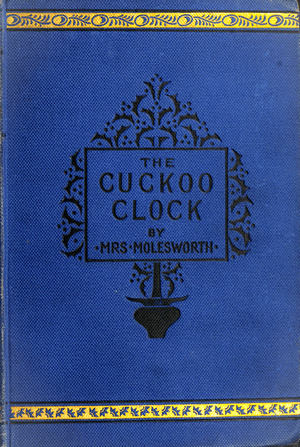The Cuckoo Clock facts for kids

Front cover of the first edition published as by Mrs. Molesworth, 1882
|
|
| Author | Mary Louisa Molesworth |
|---|---|
| Illustrator | Walter Crane |
| Country | United Kingdom |
| Genre | Children's novel, fantasy |
| Publisher | Macmillan and Co. |
|
Publication date
|
1877 |
| Pages | 242 (first edition) |
| OCLC | 6219054 |
| LC Class | PZ7.M732 Cu4 (1914) |
| Text | The Cuckoo Clock at Wikisource |
The Cuckoo Clock is a classic British children's fantasy novel. It was written by Mary Louisa Molesworth and first published in 1877. The book tells a magical story that has charmed young readers for many years. It was first released under the name Ennis Graham. Later, it was reissued under Mrs. Molesworth's more famous name. Many editions of the book, including the first ones, feature beautiful drawings by Walter Crane. Another edition from 1914 was illustrated by Maria L. Kirk.
Contents
What the Story is About
The story follows a young girl named Griselda. She is sent to live with her aunts in a big, old house. Griselda feels lonely and a bit out of place at first. Her life changes when she meets a special cuckoo from a cuckoo clock. This cuckoo becomes her secret friend. At night, the magical clock takes Griselda on amazing adventures to different, enchanted places. These journeys help her learn important lessons about life and friendship.
Why This Book is Special
Mary Louisa Molesworth's writing style is quite simple and easy to understand. This makes her books perfect for young readers. She wanted her stories to be clear and feel like a friendly chat. This simple style helps children easily follow the adventures and imagine the magical worlds she creates. The book is a great example of how a simple story can still be full of wonder and important messages.
Important Lessons and Themes
The Cuckoo Clock explores several key ideas that are still important today.
Finding Friends and Love
When Griselda first arrives at her aunts' house, she feels very alone. She soon learns how important friendship is. Her first friend is the magical Cuckoo. Later, she finds friends in the housemaids. Finally, she makes a true friend in a boy named Master Phil. By the end of the story, Griselda also realizes that her aunts have been showing her love all along, even if she didn't see it at first.
Magic in Everyday Objects
The magic in this story comes from an enchanted object: the cuckoo clock itself. This special clock can do amazing things and take Griselda to many different places. This idea of magic hidden in everyday items helps young readers use their own imaginations. It shows them that wonderful things can happen even in ordinary settings.
Hard Work Brings Rewards
Griselda sometimes struggles with her school lessons during the day. The Cuckoo helps her understand that working hard leads to good things. He shows her that if she tries her best, she will be rewarded. This teaches Griselda that effort and dedication are important for success.
Children's Books in the 1800s
The second half of the 19th century is often called the "Golden Age" of children's literature. This was a time when many famous and beloved children's stories were published. Many of these books, like The Cuckoo Clock, are still enjoyed by children today. Fantasy novels for children became very popular during this period.
Stories That Teach Lessons
Many British children's books from this time, including The Cuckoo Clock, were meant to teach children good behavior. These are sometimes called "didactic tales." Griselda is shown as a very real child. She sometimes gets upset or doesn't get her way. Through her adventures with the Cuckoo, she learns how to control her feelings and act properly. Learning to be a well-behaved child was a common theme in many books written for young people back then.

